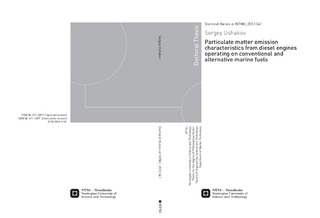| dc.contributor.author | Ushakov, Sergey | nb_NO |
| dc.date.accessioned | 2014-12-19T12:08:32Z | |
| dc.date.available | 2014-12-19T12:08:32Z | |
| dc.date.created | 2013-01-30 | nb_NO |
| dc.date.issued | 2012 | nb_NO |
| dc.identifier | 602837 | nb_NO |
| dc.identifier.isbn | 978-82-471-4007-9 (printed version) | nb_NO |
| dc.identifier.isbn | 978-82-471-4009-3 (electronic version) | nb_NO |
| dc.identifier.uri | http://hdl.handle.net/11250/238353 | |
| dc.description.abstract | The awareness of adverse health effects associated with diesel aerosol emissions has generated a great public and academic interest in studying various aerosol-producing sources. While automotive industry has achieved significant progress in controlling and reducing particulate matter (PM) emissions, there was only a very limited attention paid to ship transport, i.e. to marine diesel engines (MDE). Nowadays, shipping is one of the biggest contributors of PM emissions to the atmosphere, although is still lacking attention from PM legislators and diesels aerosol researchers. This thesis is focused on measurement and characterization of particulate emissions from diesel engines (both marine and heavy-duty) operating on conventional and alternative marine fuels.
Different PM emission characteristics such as particle size distributions, total and nanoparticle concentrations, PM mass and particle morphology were measured and analysed in current thesis. The observed significant differences in PM results between 2-stroke and 4-stroke marine diesel engines indicate the importance of engine technology, while pronounced contribution of heavy fuel oil’s ash fraction (in contrast to MGO) to solid PM reveals the importance of considering the fuel factor. In addition, PM characteristics from marine diesel engines were found to be different from that of heavy-duty engine, but a certain, somewhat surprising, agreement between results for 4- stroke MDE and 4-stroke heavy-duty engine was also observed. Particle morphology analysis confirmed the three main origins (sources) of particulates: fuel, lubrication oil and mechanical wear of moving cylinder parts.
The sole effect of high sulphur level in marine fuels was studies using a sulphur-doping of a reference low-sulphur MGO up to 4% S by mass. The contribution of sulphur to PM mass appeared to be more pronounced than is known from automotive engine studies. The homogeneous nucleation of sulphur and HC compounds was observed only at very low load conditions, while heterogeneous nucleation, i.e. condensation on the surface of existing solid particles, was found to be the dominating mechanism and can be associated with a rather low turbulence level in a primary porous tube diluter and availability of considerable amount of solid nucleus. As volatile particles are very sensitive to dilution parameters and in order to obtain repeatable and reproducible results, the effects of primary dilution ratio (PDR) and primary dilution air temperature (PDT) were studied. Both these parameters showed no effect on solid carbonaceous particles formed inside the engine cylinders, and at the same time were vital for semivolatile HC and sulphur compounds. Increase in PDR reduces the partial pressure of volatile compounds, and hence their tendency to nucleate; too low PDR should be avoided as water condensation can occur leading to some deceptive results. Increasing PDT results in increased saturation vapour pressure of volatile compounds, which is also suppressing nucleation. Effect of filter media on the results of gravimetric PM analysis was studied and no filter type was found overwhelmingly superior due to various positive and/or negative artifacts associated with each filter type.
The environmental benefits in terms of gaseous, smoke and PM emissions of fish oil (FO) biofuel and GTL synthetic fuel as alternatives to conventional MGO were investigated. A fairly good ignition and combustion properties together with excellent emission characteristics were observed in case of FO, which although requires some additional testing of its rheological and cold temperature properties and oxidation stability. GTL fuel showed reduction in PM mass, smoke and all gaseous emissions except THC, which together with registered particle number concentration showed a visible increase. This can be associated with possible higher incidence of wall-wetting by GTL fuel as its volumetric flow rates were increased to compensate for lower fuel density (lower volumetric energy content). Injection system tuning/modification or shift to common rail injection system can be proposed for reduction of gaseous (especially THC) and PM emissions even further. | nb_NO |
| dc.language | eng | nb_NO |
| dc.publisher | Norges teknisk-naturvitenskapelige universitet, Fakultet for ingeniørvitenskap og teknologi, Institutt for marin teknikk | nb_NO |
| dc.relation.ispartofseries | Doktoravhandlinger ved NTNU, 1503-8181; 2012:341 | nb_NO |
| dc.title | Particulate matter emission characteristics from diesel engines operating on conventional and alternative marine fuels | nb_NO |
| dc.type | Doctoral thesis | nb_NO |
| dc.contributor.department | Norges teknisk-naturvitenskapelige universitet, Fakultet for ingeniørvitenskap og teknologi, Institutt for marin teknikk | nb_NO |
| dc.description.degree | PhD i marin teknikk | nb_NO |
| dc.description.degree | PhD in Marine Technology | en_GB |
